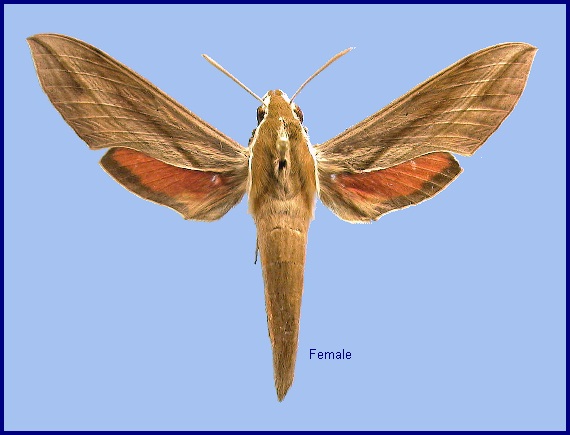
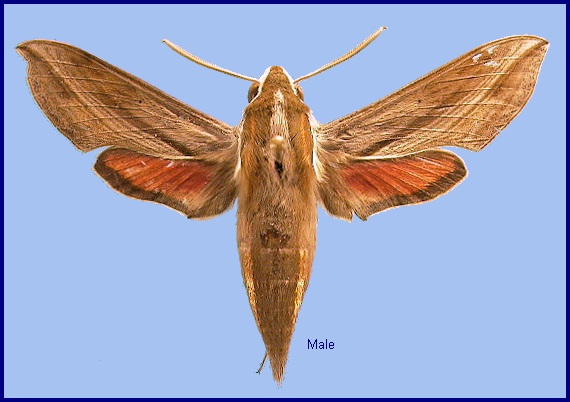
Choerocampa rosetta Swinhoe, 1892, Cat. east. and Aust. Lepid. Heterocera Colln Oxf. Univ. Mus. 1: 16. Type locality: [Indonesia, Maluku,] Ceram [Seram].
Synonym. Choerocampa rosetta Swinhoe, 1892.
Synonym. Hippotion depictum Dupont, 1941, in Dupont, F. & Roepke, W., Heterocera Javanica. Fam. Sphingidae, Hawk moths. Verh. ned. Akad. Wet. (Tweede Sectie) 40: 70. Type locality: [Indonesia,] Java.
[Further details on this species in Japan, as well as photos of many stages, can be found on Digital Moths of Japan.]
Very similar to Hippotion boerhaviae from which it is only distinguishable with certainty by the shape of the juxta. Forewing generally shorter than Hippotion boerhaviae, outer margin more convex, pattern duller and less contrasting, appearing less striped. Hindwing upperside with a buff tornal patch; median area more orange-pink than Hippotion boerhaviae. Underside of abdomen generally with either a poorly-defined narrow, pale median stripe, or lacking one entirely.
Male genitalia as Hippotion boerhaviae but juxta long, distally acutely triangular.
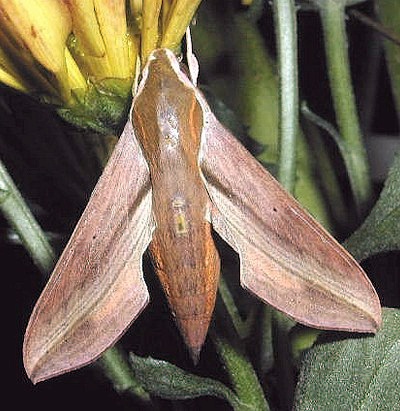
Attracted to the flowers of Lantana camara, Duranta erecta and Ixora in Hong Kong, flying for most of the night (Tennent, 1992).
China: i-xii (Hong Kong); 20-21.vi (Yunnan); vii (Hainan). Taiwan: v (Kaohsiung Hsien); vi (Taichung Hsien); vi (Nantou Hsien); vii (Nantou Hsien); viii (Tainan). Japan: 24.iv (Ryukyu Archipelago); 22.vi (Honshu); 6-20.x (Ryukyu Archipelago).
Kendrick (2002) states that it is multivoltine in Hong Kong, occurring from March until November, with peaks in late March, May and early October.
OVUM:
LARVA:
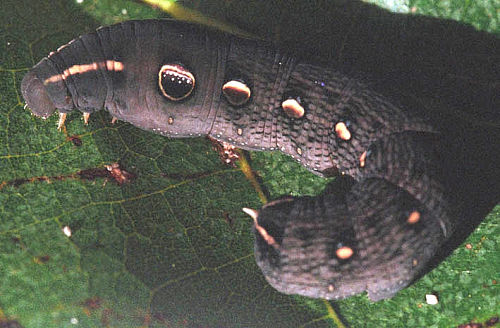
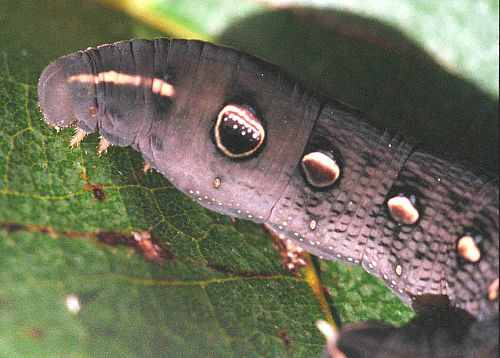
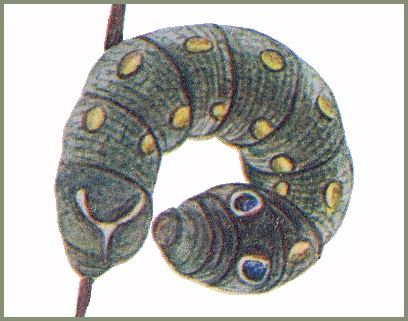
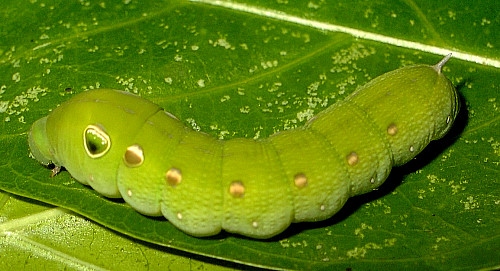
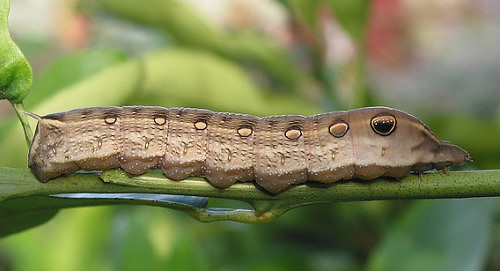
PUPA:
Larval hostplants. Mainly Borreria, Morinda citrifolia and Morinda umbellata (Rubiaceae), but also various species of Boerhavia (Nyctaginaceae). In Hong Kong it has also been found on Pentas lanceolata (David L. Mohn, pers. comm. 2005), which is also the main host in Hawaii.
On Taiwan on Oldenlandia corymbosa [syn. Hedyotis corymbosa], Morinda citrifolia, Spermacoce alata [syn. Spermacoce latifolia] and Pentas lanceolata.
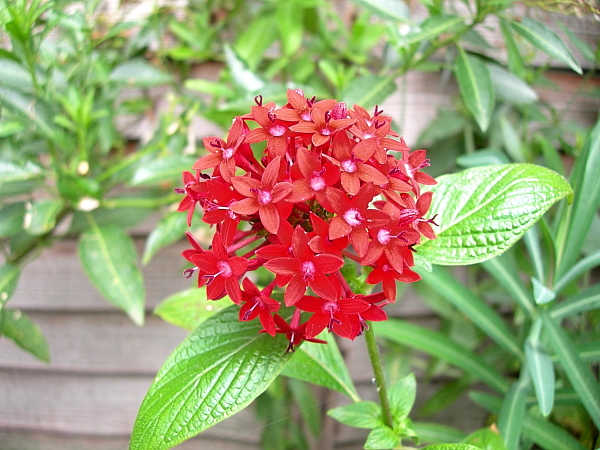
China: Yunnan (Kunming; Huanglian Nature Reserve, 2060m); Fujian (Xiamen; Yanyu Island); Guangdong (Guangzhou; Lianping; Wanzishan, Deqing; Meizhou; Shenzhen; Jiangmen); Macao; Hong Kong (Shau Kei Wan); Hainan (Chengmai; Haikou; Wenchang; Baimajing; Jianfengling National Forest Park; Wuzhi Shan; Sanya).
Taiwan: Nantou Hsien (Lushan spa; Huisun Forest; Puli); Tainan; Kaohsiung Hsien (Liukuei); Taichung Hsien (Pahsien Shan); Orchid Island/Botel Tobago.
Japan: Honshu (Taira); Ryukyu Archipelago (Okinawa; Iriomote-jima; Ishigaki-jima (Kohno, Kohno & Kohno, 2006)).
From southern Pakistan (Younus & Uddin, 2011; Rafi et al., 2014), Bhutan (Irungbam & Irungbam, 2019), India and Sri Lanka, eastwards across Thailand, southern China and Taiwan to southern Japan (Ryukyu Archipelago), the Philippines, Guam and Hawaii, and then southwards across the Indian Ocean Islands and South East Asia to the Maldive Islands, the Andaman and Nicobar Islands (Singh, Ahmad & Chandra, 2021), eastern Indonesia, the Solomon Islands and the Torres Straits of New Guinea (Lane & Moulds, 2015).
In the last 15 years this species has managed to colonize Hawaii, although it was initially misidentified as Hippotion boerhaviae. It appears to have first arrived from Guam on military transport planes like several other Sphingidae (Riotte, 1977). It has now become firmly established since its confirmed introduction in 1998 (Austin & Rubinoff, 2022).
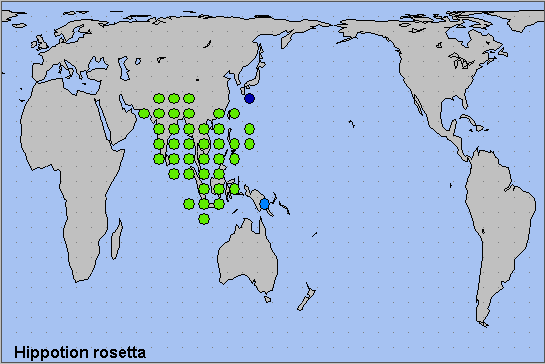
 Return to Sphingidae of the Eastern Palaearctic species list
Return to Sphingidae of the Eastern Palaearctic species list